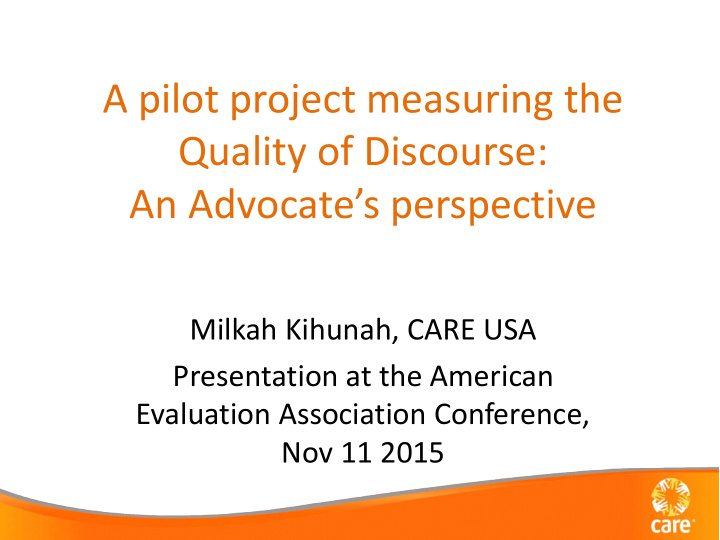



A pilot project measuring the Quality of Discourse: An Advocate’s perspective Milkah Kihunah, CARE USA Presentation at the American Evaluation Association Conference, Nov 11 2015
OUTLINE What? Policy and Advocacy context Why? Rationale for analyzing discourse How? Key steps and activities Challenges and lessons learnt
CONTEXT • CARE is a global NGO working in 80 + countries, • Priorities include influencing US foreign policy on gender equality issues globally • Progress in recent years in getting policy change e.g. on GBV, child, early and forced marriage (CEFM). • Some key questions: - Are policies being implemented? - Is CARE’s advocacy having an impact?
Policy change is messy
DIMENSIONS OF POLICY INFLUENCE • Policy change involves range of forces and actors, navigating politics and power, competing narratives, ongoing learning • Advocacy and M&E related to policy implementation particularly challenging • Different elements to influence and monitor e.g. - Policy content: important, but not enough - Actions or behavior of govt. officials - Discourse or language
Why Analyze Discourse? • Starting point was adapting policymaker scorecard to monitor Administration action • What govt. officials say matters: helps us understand thinking, outlook, priorities • Analyzing discourse can help assess advocacy impact and potentially monitor progress in implementation • Focus is analyzing change in how officials talk about child marriage
Steps/elements of strategy • Goal: Implementation of policy mandates around GBV and child marriage • Identification of key USG officials responsible for implementation (e.g. USAID, State Dept. White House) • Defining changes we would like to see e.g.. actions taken and statements made • Developing and carrying out advocacy activities
Examples of advocacy activities – Defining and disseminating messages e.g. through briefs, meetings, online campaigns – Coordinate closely with advocacy partners and coalitions e.g. Girls Not Brides coalition – Discourse monitoring and data collection e.g. meeting notes, public speeches, media statements, blogs, social media etc
Examples of discourse Community mobilization Promote girls agency Dowry Poverty? Social Alternatives norms / options for girls More than Engage men education – and boys comprehensive Girls sexuality approach & family honor
Methodology and results (Over to Susanna!)
Challenges and questions • Turnover of administration staff/officials • Discourse behind closed doors • Are the findings useful for strategic planning? • Can we discern CARE’s contribution? • Link to CARE’s advocacy goal: implementation
Recommend
More recommend